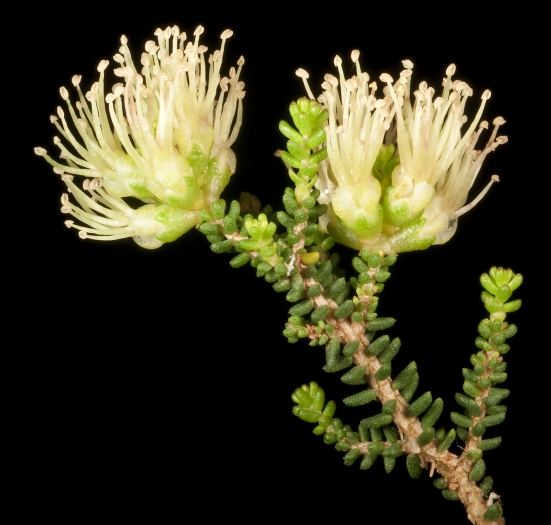Wattle Honey Myrtle
(Melaleuca micromera)
Wattle Honey Myrtle (Melaleuca micromera)
/
/

Kevin Thiele from Perth, Australia
CC BY 2.0
Image By:
Kevin Thiele from Perth, Australia
Recorded By:
Copyright:
CC BY 2.0
Copyright Notice:
Photo by: Kevin Thiele from Perth, Australia | License Type: CC BY 2.0 | License URL: https://creativecommons.org/licenses/by/2.0 | Uploader: Josve05a | Publisher: Wikimedia Commons | Title: Melaleuca_micromera_-_Flickr_-_Kevin_Thiele.jpg | Notes: =={{int:filedesc}}== {{Information |description={{en|1=''Melaleuca pulchella'' (cultivated, labelled), Royal Botanic Gardens Cranbourne, Victoria, Australia}} |date=2015-01-10 |source={{own}} |author=[[:en:User:Melburnian|Melbur



Estimated Native Range
Summary
Melaleuca micromera, commonly known as Wattle Honey Myrtle, is an evergreen shrub native to the sandy soils and coastal heathlands of Southwestern Australia. It is a rare species, valued for its unusual foliage and profuse small yellow flowerheads. This shrub typically grows erect and rounded, reaching about 3 meters (10 feet) in height and width, with distinctive twisted branches. The small, bright yellow flowers are arranged in heads at or near the branch tips and bloom in early spring, sometimes as early as July. The flowers are moderately showy and can give the plant a wattle-like appearance from a distance. After flowering, it produces woody, cup-shaped capsules. The plant’s extremely small leaves and twisted branches add to its ornamental value.
Wattle Honey Myrtle is appreciated for its reliability in cultivation, making it a suitable choice for rockeries, containers, and as a feature plant in gardens. It responds well to light annual pruning and is relatively low maintenance. In cultivation, it thrives in full sun to part shade, requires low to medium water, and prefers well-drained soils. While it is not commonly afflicted by diseases, it can be sensitive to overly wet conditions which may lead to root rot. Gardeners should be aware of its preference for a Mediterranean climate and provide protection from harsh frosts.CC BY-SA 4.0
Wattle Honey Myrtle is appreciated for its reliability in cultivation, making it a suitable choice for rockeries, containers, and as a feature plant in gardens. It responds well to light annual pruning and is relatively low maintenance. In cultivation, it thrives in full sun to part shade, requires low to medium water, and prefers well-drained soils. While it is not commonly afflicted by diseases, it can be sensitive to overly wet conditions which may lead to root rot. Gardeners should be aware of its preference for a Mediterranean climate and provide protection from harsh frosts.CC BY-SA 4.0
Plant Description
- Plant Type: Shrub
- Height: 3-6 feet
- Width: 3-6 feet
- Growth Rate: Moderate
- Flower Color: Cream, Yellow
- Flowering Season: Spring, Summer
- Leaf Retention: Evergreen
Growth Requirements
- Sun: Full Sun, Part Shade
- Water: Medium
- Drainage: Fast
Common Uses
Bee Garden, Bird Garden, Butterfly Garden, Hummingbird Garden, Low Maintenance, Showy Flowers
Natural Habitat
Sandy soils and coastal heathlands
Other Names
Common Names:
Scientific Names: , Melaleuca micromera, Myrtoleucodendron micromerum,
GBIF Accepted Name: Melaleuca micromera Schauer